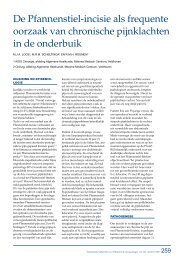Surgical management of chronic inguinal pain syndromes - Liespijn
Surgical management of chronic inguinal pain syndromes - Liespijn
Surgical management of chronic inguinal pain syndromes - Liespijn
Create successful ePaper yourself
Turn your PDF publications into a flip-book with our unique Google optimized e-Paper software.
and possible treatment effect. Ideally, these modalities aid in selecting individuals withcentral sensitisation, a condition that probably forms a contraindication for intendedperipheral nerve surgery.Procedure-related factors also deserve discussion. From an empirical point <strong>of</strong> view, ameticulous operative technique with proper nerve identification and preservation is acrucial first step in <strong>pain</strong> prevention. However, is there still any merit in studying alternativemesh materials with respect to <strong>chronic</strong> <strong>pain</strong>? Recently, a self-fixing mesh (ParieteneProgrip®, S<strong>of</strong>radim Production, Trévoux, France-Group Covidien) became availablethat adheres to the operative field using vicryl micro-hooks omitting the need for suturefixation 35 . This technique prevents suture-induced nerve entrapment whereas its semiresorbableconstruction may reduce <strong>chronic</strong> nociceptive <strong>pain</strong> such as periostitis pubis.A randomized controlled trial using this mesh is has been performed by our group <strong>of</strong>investigators (PARADE trial, NTR 1212) and the results will be expected shortly. Biologicalmeshes composed <strong>of</strong> a porcine or human extracellular matrix stripped <strong>of</strong> its cellularcomponents are being studied by other hernia surgeons. The effect on <strong>chronic</strong> <strong>pain</strong> isstill unclear but improved biocompatibility may result in diminished nociceptive <strong>pain</strong>.When <strong>pain</strong> tends to chronify, its appearance and cause should be recognized by treatingsurgeons. Improved awareness requires education <strong>of</strong> both patients and doctors.Recognition <strong>of</strong> post-Pfannenstiel <strong>pain</strong> <strong>syndromes</strong> is currently lacking and deservesattention <strong>of</strong> gynaecologists. An internet site can provide useful information (e.g.www.liespijn.nl, which will be online soon).An important under-acknowledged aspect <strong>of</strong> <strong>inguinal</strong> <strong>pain</strong> <strong>syndromes</strong> is sexual intercourse-relatedor ejaculatory <strong>pain</strong>. These debilitating <strong>syndromes</strong> affect both sexes andmay occur after <strong>inguinal</strong> hernia repair and Pfannenstiel incisions. The beneficial effect<strong>of</strong> neurectomy and mesh removal on intercourse-related <strong>pain</strong> is incidentally recordedand merits future investigation.Management protocols for <strong>chronic</strong> <strong>inguinal</strong> <strong>pain</strong> are unavailable in most general hospitals.Therefore, a diagnostic algorithm may be helpful and is provided in this thesis (seeappendix for examples). Guidelines allow for a sensible approach and create uniformityin data <strong>management</strong>. Management must be supported by psychological assessmentsas <strong>chronic</strong> <strong>pain</strong> is frequently associated with catastrophic thinking and depressivethoughts. A downward spiral may subsequently aggravate <strong>pain</strong> sensation.Knowledge on therapeutic options is still limited. Operative neurectomy is beingperformed on a small scale with average success rates reaching 60-70% at most. As aconsequence, a significant group <strong>of</strong> patients is left with persisting <strong>pain</strong>. The underlyingmechanisms <strong>of</strong> treatment failure require full investigation. Non-operative treatmentoptions such as pulsed radio frequency and pharmacological treatment (e.g. Pregabaline/Lyrica®) must be explored in controlled studies. Ideally, complex <strong>pain</strong> patientsshould be discussed in a multidisciplinary team consisting <strong>of</strong> surgeons, anaesthesiologists,neurologists and psychologists/ psychiatrists. The complexity <strong>of</strong> these <strong>pain</strong><strong>syndromes</strong> demands maximal expertise <strong>of</strong> a group <strong>of</strong> dedicated specialists.REFERENCES1 Bay-Nielsen M, Perkins FM, Kehlet H. Pain and functional impairment 1 year after <strong>inguinal</strong>herniorrhaphy: a nationwide questionnaire study. Ann Surg 2001; 233: 1-72 Luijendijk RW, Jeekel J, Storm RK, Schutte PJ, Hop WC, Drogendijk AC, Huikeshoven FJ. The lowtransverse Pfannenstiel incision and the prevalence <strong>of</strong> incisional hernia and nerve entrapment.Ann Surg 1997; 225: 365-3693 Nienhuijs S, Staal E, Strobbe L et al. Chronic <strong>pain</strong> after mesh repair <strong>of</strong> <strong>inguinal</strong> hernia: a systematicreview. Am J Surg 2007; 194: 394-4004 Franneby U, Sandblom G, Nordin P, Nyrén O, Gunnarsson U. Risk factors for long-term <strong>pain</strong> afterhernia surgery. Ann Surg 2006; 244: 212-2195 Courtney CA, Duffy K, Serpell MG, O'Dwyer PJ. Outcome <strong>of</strong> patients with severe <strong>chronic</strong> <strong>pain</strong>following repair <strong>of</strong> groin hernia. Br J Surg 2002; 89: 1310-13146 Kehlet H, Jensen TS, Woolf CJ. Persistent postsurgical <strong>pain</strong>: risk factors and prevention. Lancet2006; 367: 1618-16257 Kehlet H. Chronic <strong>pain</strong> after groin hernia repair. Br J Surg 2008; 95: 135-1368 Alfieri S, Di MD, Doglietto GB. Prophylactic ilio<strong>inguinal</strong> neurectomy in open <strong>inguinal</strong> herniarepair. Ann Surg 2007; 245: 6639 Picchio M, Palimento D, Attanasio U. Randomized controlled trial <strong>of</strong> preservation or electivedivision <strong>of</strong> ilio<strong>inguinal</strong> nerve in open <strong>inguinal</strong> hernia repair with polypropylene mesh. Arch Surg2004; 139: 755-75810 EU Hernia Trialists Collaboration. Repair <strong>of</strong> groin hernia with synthetic mesh: meta-analysis <strong>of</strong>randomized controlled trials. Ann Surg 2002; 235: 322-33211 Neumayer L, Giobbie-Hurder A, Jonasson O, Fitzgibbons R Jr, Dunlop D, Gibbs J, Reda D, HendersonW, Veterans Affairs Cooperative Studies Program 456 Investigators. Open mesh versuslaparoscopic mesh repair <strong>of</strong> <strong>inguinal</strong> hernia. N Engl J Med 2004; 350: 1819-182712 Bringman S, Wollert S, Osterberg J, Smedberg S, Granlund H, Felländer G, Heikkinen T. One yearresults <strong>of</strong> a randomised controlled multi-centre study comparing Prolene and Vypro II-mesh inLichtenstein hernioplasty. Hernia 2005; 9: 223-22713 Bringman S, Wollert S, Österberg J, Smedberg S, Granlund H, Heikkinen TJ. Three-year results <strong>of</strong>a randomised clinical trial <strong>of</strong> lightweight or standard polypropylene mesh in Lichtenstein repair<strong>of</strong> primary <strong>inguinal</strong> hernia. Br J Surg 2006; 93: 1056-105914 O'Dwyer PJ, Kingsnorth AN, Molloy RG, Small PK, Lammers B, Horeyseck G. Randomized clinicaltrial assessing impact <strong>of</strong> a lightweight or heavyweight mesh on <strong>chronic</strong> <strong>pain</strong> after <strong>inguinal</strong>hernia repair. Br J Surg 2005; 92: 166-170146 Chapter 10Summarizing discussion, conclusions, and future perspectives 147





